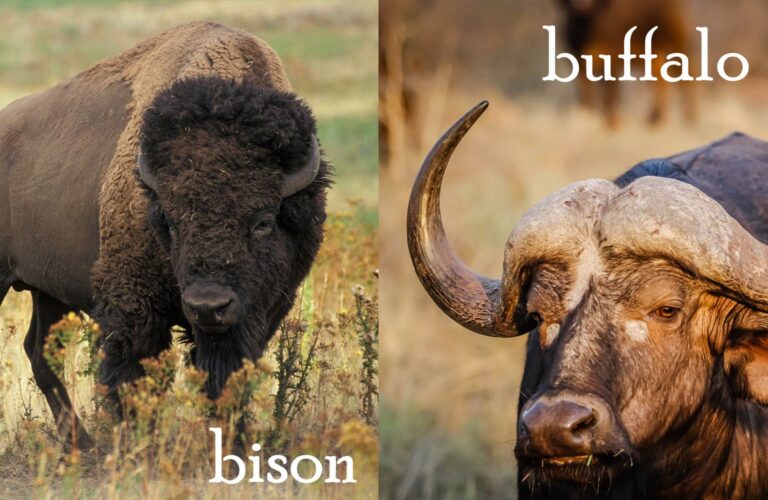Bison and Buffalo are animals that are commonly confused for one another. Why? Because back in the good ol’ days before the advent of the internet, the early settlers thought the two animals were the same or, at least, similar.

They didn’t have a ton of resources with which to identify that these were in fact two completely different animals. So what are the differences between bison and buffaloes?
Bisons are larger, they weigh more, and they are taller than buffaloes. Buffaloes have longer horns, though. They both can reach top speeds of 35 mph.
Their social dynamics are also entirely different; while buffalo typically travel in large herds of between 50 and 500 members (1000 in the rainy season), bison have separate herds of males and females which only mingle around mating season.
| Trait | Buffalo | Bison |
|---|---|---|
| Size | Larger | Smaller |
| Weight | Up to 1900 lbs. (900 kgs) | Up to 2200 lbs. (1000 kgs) |
| Family | Bovidae | Bovidae |
| Diet | Herbivore | Herbivore |
| Head size | Smaller | Larger |
| Beards | No | Yes |
| Top speed | 35 mph | 35 mph |
| Height | Up to 11ft 1” (3.4 meters) | Up to 12ft 5” (3.8 meters) |
| Horn length | Up to 2 meters, sharper | Up to 0.5 meters, not as sharp |
| Travel pattern | Mixed groups | Male and female travel separately |
Three Buffalo Species
There are three species of buffalo:
- African Buffalo are found only in sub-Saharan Africa. There are four subspecies of African buffalo: the Cape buffalo, central Africa Savanna buffalo, Forest buffalo, and West African Savanna buffalo.
- Wild Asian Water Buffalo are native to the Indian sub-continent.
- Domestic Asian Water Buffalo are also native to the Indian sub-continent but are also found in China and throughout South East Asia.
Bison Species
There are also three species of bison which are:
- The American bison which can be found throughout North America.
- The wood bison which is a subspecies of the American bison is found in Alaska and Canada.
- The European bison which is found mostly in Poland.
Appearances can be Deceiving
Bison and buffalo are both members of the Bovidae family of the animal kingdom. Both animals are herbivores which travel in herds and have horns.
You wouldn’t think it to look at them – looking at a bison it sort of looks like a very big cow but don’t be fooled. While bison and buffalo are both relatively peaceful animals, you really don’t want to pick a fight with either one!
When threatened, these animals can use both their sizable weight and sharp horns to do some serious damage.
Let’s take the American bison as an example, it’s the largest of the bison species, and can reach a weight of between 1 and 2000 kilograms.
A bison is incredibly front-heavy by virtue of its big head and the large hump of muscle situated on its back near the shoulders. This is so that it can use its head to plow through the heavy snow drifts in the winter.
Now, imagine that big head, with some 2000 kilograms behind it pressing against your chest…yeah, not pleasant. You’re going to be in very bad shape – assuming the impact doesn’t kill you – and the short, sharp horns tearing through your flesh and muscle will likely finish you off.
Oh, and if you’re thinking you’ll outrun an angry bison or buffalo; you’re wrong. The average human can run about 6 miles per hour, but they can’t maintain that speed for more than a few seconds.
Both buffalo and bison can run at a whopping 35 miles per hour– although, buffalo can’t maintain that speed for very long. Bison can maintain that speed for up to five miles.
They’re also incredibly agile, able to turn on a dime without losing much – if any – momentum.
Differences Between Bison and Buffalo
Appearance
Let’s start off with the obvious, these two animals look completely different.
Bison have a stockier build, with a large hump on broad shoulders and a big, broad head and short, sharp horns.
They also have a shaggy beard and a thicker coat. Buffalo, on the other hand, have much smaller heads and shoulders. They have no hump but are a more streamlined structure and longer horns. Their coats are thinner, and they have no beard.
Size
The American Bison typically reach around 3.8 meters in length, and can weigh up to 1,000 kilograms or more.
On the other hand, a Cape buffalo can reach around 3.4 meters in length and can weigh up to 900 kilograms. A water buffalo is the heaviest of both species, weighing around 1200 kilograms. It’s also the smallest of the two species, reaching only 2.7 meters in length.
Horns
Buffalo and bison both have horns. A bison’s horns are shorter and, usually, sharper than the horns of a buffalo. The length of a bison’s horns typically reaches around 0.5 meters.
Buffalo horns, on the other hand, are longer – reaching around 2 meters in length – and are handlebar-shaped.
Coat
Bison and buffalo have different natural habitats. Bison are typically found in colder climates in North America, Alaska, and parts of Europe – notably Poland. On the other hand, buffalo are found in much warmer climates in Africa and Asia.
Buffalo are exposed to a smaller range of temperatures and have a very thin, smooth coat. They also don’t shed. Bison have a shaggy double-layered coat which allows them to stay warm in the harsher winter climates in which they live. Their inner coat is shed during the warmer months.
Herd Behavior
Buffalo and bison are both very social animals and travel in herds. Buffalo herds consist of between 50 and 500 members for most of the year. The herds can grow to 1000 members in the rainy season.
Bison, on the other hand, travel in separate herds of males and females – until mating season when the two meet up and mingle for a while to…well…mate.
Conclusion
Before we close off, let’s have a quick recap:
- Bison have a larger, stockier body with a large hump, thick, double-layered coat, and big head; they also sport beards. Buffalo have a smaller head and body, and thinner, sleeker coat.
- Bison horns are shorter and sharper than their buffalo counterparts
- Buffalo travel in groups that can reach up to 1000 members, while bison travel in separate herds of males and females – only coming together (excuse the pun) in mating season.
Well, I think that about covers everything. I hope you guys enjoyed reading this article and found it informative. As always, I’d like to close off by saying thank you for reading and I’ll see you all again very soon.
Take care!

Greg spent most of his childhood in camping grounds and on hiking trails. While he lives in the suburbs nowadays, Greg was raised on a small farm with chickens. He’s a decent shot with a bow, and a huge knife enthusiast. Find out more about Greg.
